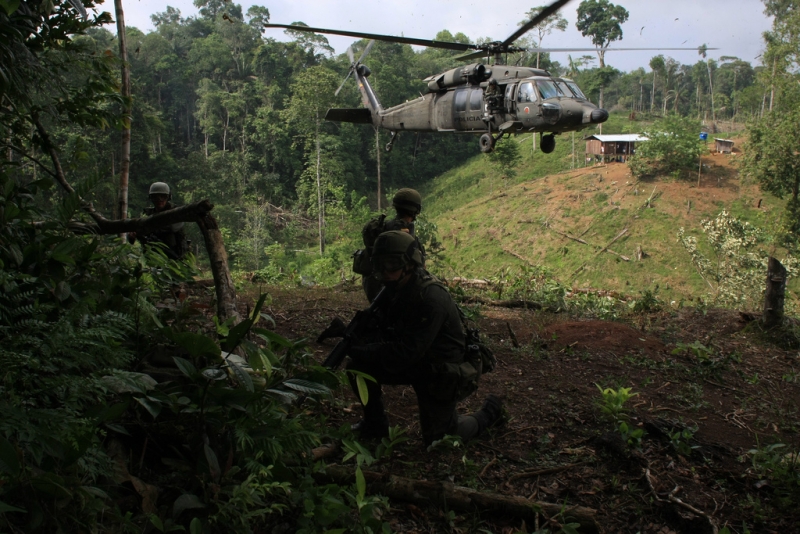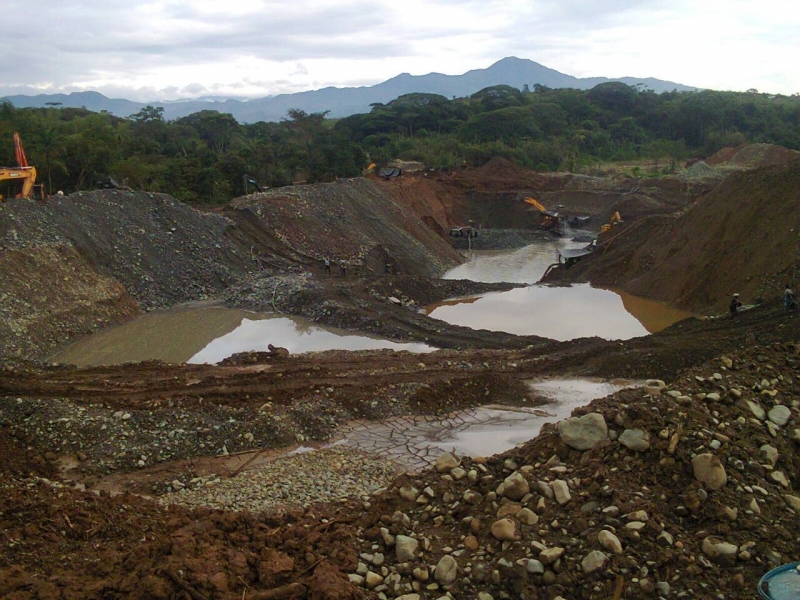Colombia’s government and FARC rebels signed a historic peace accord in late 2016, ending a civil war that caused over 220,000 deaths and the internal displacement of over 7 million people. In addition to devastating lives and livelihoods, the civil war was destructive to the environment. Following historic negotiations and the congressional ratification of a revised agreement, Colombia still faces environmental risks in a time of relative peace. It is crucial that ongoing talks and reforms in the wake of over five decades of conflict take these factors into account in order to ensure sustained peace and development for the future.
Environmental Causes & Casualties of Civil War
One reason it is critical to take into account environmental factors is that Colombia’s civil war was essentially the result of unaddressed socio-environmental grievances. Extremely uneven distribution of land, and the question of land tenure, has been a cause of tension in Colombia for two centuries (agrarian reform is an integral part of the FARC’s and other rebel groups’ political and ideological platforms). Studies show that the distribution of land has become increasingly skewed, with about 0.4 percent of farms owning about two-thirds of agricultural land.
In addition, natural resources financed this conflict and were sometimes targeted as a method of war, resulting in extensive environmental damage. Oil pipelines, especially those owned by foreign companies, were blown up or destroyed, spilling 3 million barrels of oil into Colombia’s soil and water (this tactic has been used as recently as January 2018, although not by the FARC). Especially in recent years, armed groups have used gold to generate revenue and launder money. A 2010 ombudsman report stated that one-half of Colombia’s gold mines were illegal, many of which are run by armed groups. Unregulated mining is often an intensive activity that causes mercury, chemical, and sediment pollution.
 Perhaps the most infamous conflict resource used to finance armed groups in Colombia is coca, which is used to produce cocaine. Estimates show at one point, the FARC owned 70% of coca crops in Colombia. Coca production (and razing forests to create airstrips for transporting coca-based products) has driven deforestation in Colombia to some extent. Ironically, this is in part because of aerial and manual eradication policies. The destruction of coca (and sometimes other) crops often pushed farmers to new frontiers - or, more remote, forested regions that are less likely to be detected or controlled by government forces.
Perhaps the most infamous conflict resource used to finance armed groups in Colombia is coca, which is used to produce cocaine. Estimates show at one point, the FARC owned 70% of coca crops in Colombia. Coca production (and razing forests to create airstrips for transporting coca-based products) has driven deforestation in Colombia to some extent. Ironically, this is in part because of aerial and manual eradication policies. The destruction of coca (and sometimes other) crops often pushed farmers to new frontiers - or, more remote, forested regions that are less likely to be detected or controlled by government forces.
Under PlanColombia and with U.S. support, aerial fumigation campaigns are sometimes used to destroy coca plants; but, the herbicide used (glyphosate, also known as Roundup) also killed other native or agricultural flora while often failing to weed out the target crop. Glyphosate is in fact a known carcinogen, which contaminated water and damaged livelihoods. Altogether, these campaigns have had ambiguous results, with many arguing that the few successes were achieved at too great a cost. Without question, this civil war has had devastating impacts on Colombia’s rich natural heritage and on the lives depending on it.
New Risks & Reasons in Peacetime
The peace agreement signed in Havana in November 2016 was historic for many reasons. Ratification by popular referendum failed by a narrow margin, but a revised agreement was passed in Colombia’s Congress. Negotiations resulted in a plan acknowledging the importance of resource tenure and land reform, among other important topics. With relative peace and reforms underway, Colombia faces different, but not wholly new, risks and drivers of environmental degradation.
Many zones that were either controlled by or in the crossfire of armed forces are suddenly relatively less dangerous. Programs for removing landmines and unexploded ordnance are underway—unequivocally a positive development. Partially facilitated by a land restitution unit established by a 2011 law, formerly displaced persons are returning home and being acknowledged as victims of the war. Routes previously controlled by the FARC may be accessible for use more widely, providing opportunities to expand commerce.
While guerrillas and warfare damaged the environment, their presence also prevented the exploitation of large natural areas. After decades of war, there is an understandable desire for economic development, especially in rural areas. And now, there are fewer disincentives for converting land from native ecosystems for agricultural uses, energy infrastructure, and other extractive activities.
 This new paradigm is not only tempting for people returning home, though. Different armed groups, new settlers, and even private-sector actors now have an opportunity to fill a power vacuum. Unfortunately, both licit and illicit agriculture (timber, cattle, etc.), mining (such as gold), and commerce are increasingly feasible in previously isolated or conflict-affected areas. Just as during the war, these activities threaten to displace people and finance violence. Without careful consideration, progress toward sustained peace and economic development may result in extensive environmental degradation—or perhaps worse—revert to earlier patterns of grievances and conflict.
This new paradigm is not only tempting for people returning home, though. Different armed groups, new settlers, and even private-sector actors now have an opportunity to fill a power vacuum. Unfortunately, both licit and illicit agriculture (timber, cattle, etc.), mining (such as gold), and commerce are increasingly feasible in previously isolated or conflict-affected areas. Just as during the war, these activities threaten to displace people and finance violence. Without careful consideration, progress toward sustained peace and economic development may result in extensive environmental degradation—or perhaps worse—revert to earlier patterns of grievances and conflict.
The Path Ahead
There is incredible potential to draw benefits from Colombia’s wealth of natural resources. However, this must be done in a way that ensures a healthy environment and a fair distribution of these benefits for generations to come. The Havana dialogues and peace agreement include provisions for comprehensive rural development (including food security), attempting to directly address the problem of uneven land ownership and forced displacement. The agreement also sets forth goals for eliminating the illicit crop and drug problems.
One approach is to create alternative livelihood strategies by encouraging crop substitution, but challenges remain (licit crops are not as lucrative and may still be looted by armed groups). There is also the question of socioeconomic reintegration of FARC fighters, who now largely rely on agriculture and related labor to support their livelihoods. Making alternatives to participation in illicit exploitation of natural resources truly viable will be crucial for protecting the environment and preventing armed groups from profiting off of the land.
Additional conservation and development efforts, such as the creation of protected areas or the building of new infrastructure, will have to be accompanied by both the enforcement of existing environmental protections and sensitivity to the fact that many people—both the internally displaced and the indigenous—rely on so-called wild lands for survival. Public participation mechanisms throughout the peace process, as well as in the context of planning and development can be instrumental if adequately implemented and enforced. Otherwise, there is a risk of continuing or reverting to the same disrespect of rights to life and resources that has caused grievances for decades. In a context where the environment has had such a prominent role, defenders of land and resources require protection, as well.
Colombia’s peace process faces many challenges—including rebuilding trust, finding ways to develop and sustain livelihoods, quelling remaining guerrilla and paramilitary forces, and effectively reforming the land tenure system. Nearly all remaining challenges are linked to the environment, and new risks related to natural resources have emerged. Making the most of current opportunies to strengthen good environmental governance and promote truly sustainable development will require a concerted effort by the Colombian government and the international community—and will be critical to keeping the country on the path to sustained peace.
To learn more about environmental factors in conflict and peace dynamics and explore Colombia as a case study, sign up for the MOOC on Environmental Security & Sustaining Peace. Visit http://environmentalpeacebuilding.org/ for more information about ELI’s work and additional resources on related topics.
A summary of Colombia’s Agreement to End Conflict and Build Peace is available here.
